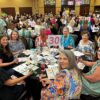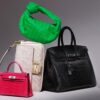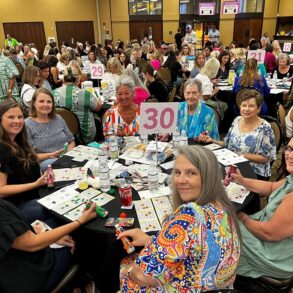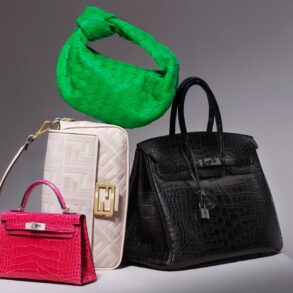
The allure of designer goods is multifaceted. Clothing and accessories from the likes of Chanel, Dior, and Prada are met with admiring eyes, a reach around for their tag, and an inevitable gasp. The price we pay, we believe, is for high-quality and fine craftsmanship, as well as an enduring and timeless appeal. But what if what we think we’re paying for turns out to be just a very good fake? Unfortunately, there’s an inauthenticity scandal afoot that’s mocking our purse strings as well as our outfits.
Counterfeit products loom behind the success of authentic designer items, like that guy who bought you a drink at the bar and now thinks he owns your night. And while some people find it shameful to wander the streets swinging their imposter Hermès Kelly bag, others take pride in their replica. Never forget when Sex and the City’s Samantha Jones, a top P.R. agent with—it appeared—disposable income, fell for knockoff Fendi bags (or baguettes) in the back of some dude’s car. Carrie Bradshaw, on the other hand, the Pied Piper of designer goods, felt the magic was lost.
With the search term ‘best fake luxury handbags’ sitting at 155.9M views on TikTok, one might think that Gen-Zers are behind this push of intrigue towards replica items, but even the most affluent have a few fakes in their closets. For those who can’t afford the ‘real thing’ or don’t want to spend their money on it, finding a good fake feels equal parts naughty and nice. A good fake represents good craftsmanship and commitment to the art of design. But it’s still a copy. And it’s available at far less of the price, meaning you can spend your money elsewhere while maintaining the glamorous appeal of a designer item. As much as brands resent the abundant availability of replicas, the market seems to be consistently growing alongside the luxury houses’ success. One study showed that international trade of counterfeit goods amounted to close to 464 billion dollars in 2019, and that was pre-covid times. Since then, our passion for (fake) fashion has only increased.
So, it’s big business. And, said without judgment, to each their own. Seriously. The issue lies when consumers go shop online and in-store in good faith that they’ve just bought a designer item when the reality is it’s a replica. Whether you like her or not, Bethenny Frankel has been doing the sartorial God’s work by bringing to light an issue that’s been brewing for some time. On her TikTok, Frankel reveals the story of her purchase of a Chanel purse from an undisclosed seller in which two authenticators swiftly informed her that it was, in fact, a fake (pause for sharp intake of breath). She continues to educate her 1.5 million followers on the points of discourse: the color of the gold, the alignment of the two Cs that make up the famous logo, and the type of acrylic used. Part way through, she explains, “It’s always best to buy in the store. Buying real means it’s an investment and something you can pass down to your kids.” However, her non-reality-TV-scripted plot thickens as buying in-store, for Frankel, doesn’t mean purchasing a legitimate, authentic designer item. At T.J. Maxx, a trusted American department store chain, the Manolo Blahnik “flamingo flats” she bought were fake. Jack Savoie, a fashion influencer, spotted the fake, noting a few discrepancies in the luxury shoes’ aesthetic, such as color, logo, stitching, and faded soles. The comment section’s consensus is that this is not an isolated issue. Tiffany Keriakos, the CEO of Designer Revival, an authenticated luxury consignment, told Coveteur that the “Manolo Blahnik shoe that surfaced in Bethenny’s Frankel’s TikTok video could have been the result of a bait and switch situation, where a customer buys the authentic item and then returns it, replacing it with a lower quality but nearly identical fake.” We’re not only up against the store’s reputation and the brand’s reputation, but we also need to be eagle-eyed toward customers.
Across the pond in Australia, Cosette is a store in Sydney that sells designer goods for a discounted price. Supposedly. Yet many blissfully unaware customers have reported their purchases to Fair Trading as counterfeit. The company clapped back, stating that all their products are genuine with third-party authentication. As it takes time to authenticate and get all the documentation ready, we might wait a while for a complete answer, apology, and product recall from Cosette.
How can we know we’re not being duped into it if we’re buying online from resellers, vintage markets, and in-store from reputable companies? We need qualified hands and eyes to save us from the tumultuous depths of the counterfeit market. This is where authenticators come in for their expertise and our peaceful purchases. The team at Real Authentication, who verify the authenticity of new and used luxury items with their eminent brand experts, believe: “Department stores and luxury boutiques have been slow to improve return fraud protocols around authenticity. When it comes to designer goods, we always recommend using a third-party authentication service.”
For the untrained eye, Keriakos says that as far as authentication for new and used designer items, we should at least have “original packaging, legible serial number, dust bag, and an authentication card or certificate depending on the designer brand and period of the item’s production.” It’s not just a run-of-the-mill purchase; the item’s documentation and packaging should represent that. With the bait-and-switch ‘model’ potentially opening up the avenues of exploitation, Keriakos notes that “the allure of luxury at a lower cost is a driving factor as well as the viral conversation around democratizing luxury, which unfortunately contradicts its very nature. This isn’t to say that more people should not be able to appreciate fashion, but that it should be pair with respect and reverence for the quality, craftsmanship and thought that goes into true designer pieces. As the online market expands, so does the opportunity for counterfeits to infiltrate.” Thus reigniting the need for trusted sources like authenticators.
There are things you can do as a consumer to arm yourself against fraud, such as researching what the item should look like, comparing the item online and in-store, and sniffing the thing. Really. The authentication experts at Real Authentication warn: “Watch out for anything with a strong plastic or gasoline odor [as] counterfeit products do often encompass a faint to strong, offensive odor.” (For the more qualified nose, ‘fake-hunters’ have revealed that Gucci apparently smells like wood, whereas Hermès is more smokey). Just avoid eye contact with the sales assistants when you’re sniffing in-store.
Naturally, this will bring into question the legitimacy of sites like Vestiaire Collective or The RealReal. Something so luxurious as buying a new or used designer item is now being questioned and it requires many eyes to confirm that what you have is the real thing. Should retailers, such as T.J.Maxx have authenticators on-site? Should their customer query the authenticity of a product? Perhaps. But will it taint the buying experience?
All is not lost though with luxury retailers. “Improvements can be made to incorporate more robust authentication protocols at the point of acquisition and point of return,” says a representative from the Real Authentification. “Retailers aren’t the enemy here; scammers are. Most of the time, you will shop with a seamless experience, but just as you wouldn’t purchase a used car without a third-party inspection, we recommend adopting the same practice for luxury goods.”
This post was originally published on this site be sure to check out more of their content.







